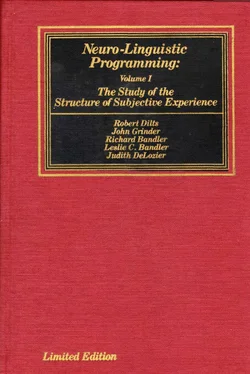In designing strategies there will be some cases where any new sequence of representations you design will be more effective than the existing one. You may even wish to experiment by changing around various sequences for a particular strategy just to find out how the outcome will be affected.
When you are trying to tailor a specific strategy for a specific task and for a specific client it will be important, in addition to taking into account which kinds of discriminations in which representational systems are required for the task, to take into account the natural abilities of the client to access, gather information, and make discriminations in the various represntational systems. The design of your strategy will have to take into consideration which resources are missing and which are present in your client's existing repertoire of strategies and abilities. Some individuals, for instance, may have very limited abilities for accessing and making discriminations in one of their representational systems, and the programmer may have to first help the individual develop the representational system so that it is useful, before he can design it into a strategy. Such training may sometimes consume a considerable amount of time and energy, and the programmer may want to make a "cost–benefit" analysis as to whether it will be more beneficial to develop a particular representational system or synesthesia pattern to fit the requirements of a strategy, or to redesign the strategy to fit the existing resources of the individual.
Some people have strong and inflexible synesthesia patterns that divert or interfere with a designed strategy sequence. An individual, for example, who has a highly developed visual–to–kinesthetic synesthesia pattern may have a very difficult time performing that operation in reverse — that is, going from feelings to images. In such cases much time may have to be spent interrupting the inflexible synesthesia pattern and rehearsing and developing the new one(s).
The time spent on developing representational systems and flexibility in synesthesia patterns, however, is generally well worth the trouble. Teaching somebody to access and gather information through an underdeveloped representational system can bring about dramatic changes.
One of the authors was once working with a person who had been diagnosed and institutionalized as a paranoid schizophrenic. The author quickly noticed that the person had one essential strategy for decision making, motivation, remembering, etc. This strategy was to take any of the experiences in his other representational systems and transform them into internal kinesthetic sensations. Although this was limiting in itself, it was complicated by the fact that the person was only able to make three basic distinctions in his kinesthetic experience — "anger", a kind of neutral calmness and a kind of "fear/paranoia". All of the person's ongoing experience was interpreted and boiled down into one of these three categories, with a primary emphasis on "fear/paranoia," of course. As therapy, the person was simply taught to make more and more distinctions in his kinesthetic experience and to practice different synesthesia patterns. As his ability to discriminate feelings improved, his repertoire of behavior increased rapidly (much to the surprise of the hospital staff) because it was no longer always channeled through the previous kinesthetic bottleneck of three feelings. As the person's feelings and choices of behavior expanded so did his ability to get along with the staff, and he was eventually discharged from the hospital.
People who are depressive often share a strategy similar to that of the person described above; only the content of their feelings is different. All of their strategies end up in negative K iwhich tends to create a self–fulfilling and reinforcing belief system, or strategy, that everything is negative. They can always validate this belief by tacking on a negative K ito any particular ongoing experience. Therapists often have a difficult time helping depressives because it is hard to access resources for them. If you try to persuade them to think of a time they felt good, they may be able to remember the experience but end up feeling worse because they are unable to feel that way now. They may feel that they were once able to be happy but that it's all gone now. Typically, they will have a polarity response to any positive experience you attempt to access as a resource.
Their problem is not, of course, that they really don't have resources — everyone has experiences that can serve as resources, no matter what his personal history has been like. Nor is their problem the inability to access resources — anyone who can see, hear or feel can do that. The root of the trouble is in their strategy for responding to the given context — the therapeutic context, for instance when asked to make a decision about whether they have pleasant memories, or whether they have the ability to recall such memories. Some depressives will have a polarity response to qualitative (interpretive/judgemental) words but not to sensory specific description. For instance, if you ask them if they ever had a good, positive or happy experience, they will have a polarity response. If, on the other hand, you ask them if they can think of a time when they could see clearly, were breathing fully and regularly in their stomach, etc., no such polarity response occurs.
If you find that a person you are working with has a strong polarity response you can always utilize it by "playing polarity" with them. You can say, "You know … I don't think there's any hope at all for you .. . you have absolutely no resources or positive abilities that I can tell… You're a hopeless case . .." If the person has a polarity strategy, they will have to have a polarity response to this statement, too and come up with resources.
Another way to deal with these cases, of course, is to bypass the person's existing strategy by designing and installing a completely new strategy. You will generally want to do this covertly so the person will not have a chance to process the new strategy through their old strategy before it has been installed. You may also need to interrupt their existing strategy in order to install the new one (for information on how to do this see the Installation Section of this book).
Once one of the authors was working with a depressed person and encountered a strategy such that whenever the man tested his internal feelings – and found that they were positive, a voice would trigger in his head and say, "This can't last … I always end up feeling bad again eventually … so I might as well start feeling bad now …" The author redesigned the content of the strategy so the test and the verbalization were reversed, and installed it in place of the other strategy. With the new strategy, every time the person found himself feeling bad, he would say to himself, "This can't last … I'll end up feeling good again eventually … so I might as well start now …"
5.31 Well–Formedness Conditions for Artificial Design.
As we have stated, the goal of artificial design in strategy work is to create the strategies that will most efficiently and effectively secure a particular outcome. This requires that the programmer discover: 1) what kind of information (for both input and feedback purposes) needs to be gathered, and in which representational systems, in order to achieve the outcome; 2) what kind of tests, distinctions, generalizations and associations need to be made in the processing of that information; 3) what specific operations and outputs need to be elicited by the individual or organization in order to achieve the outcome; and 4) what is the most efficient and effective sequence in which all of these tests and operations should take place. When you are tailoring your design to a specific client, it will be necessary to find out which abilities and resources are already present within the client's repertoire of behavior, which are missing and which are needed. We have developed a set of four general well–formedness conditions for design to help you find what is present, missing or needed in your client's existing strategies, and which, if the conditions are met, will insure that the strategies you design will be efficient and effective:
Читать дальше











